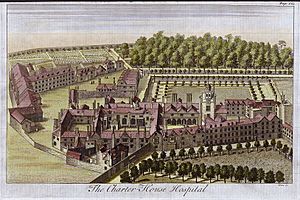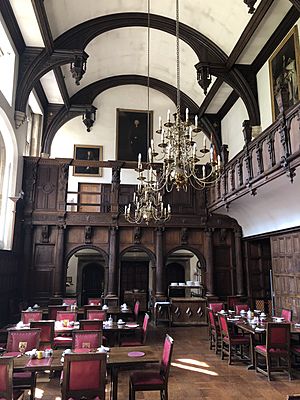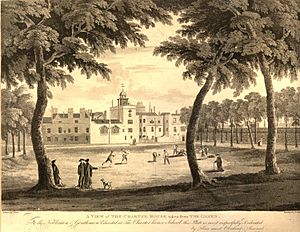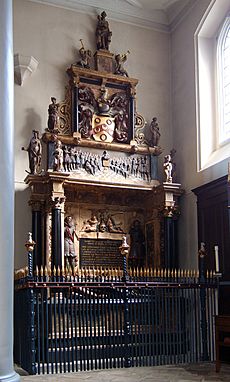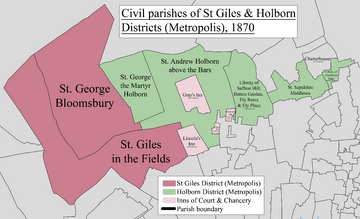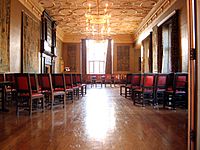London Charterhouse facts for kids
Quick facts for kids The Charterhouse, London |
|
|---|---|
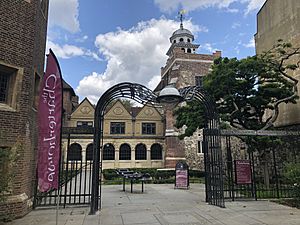
Entrance from Charterhouse Square
|
|
| Type | Almshouse |
| Location | Islington, |
| Area | London |
| Built | 1371-1951 |
| Governing body | Charitable trust |
|
Listed Building – Grade I
|
|
| Official name: The Charterhouse, Charterhouse Square | |
| Designated | 29 December 1950 |
| Reference no. | 1298101 |
| Lua error in Module:Location_map at line 420: attempt to index field 'wikibase' (a nil value). | |
The London Charterhouse is a very old group of buildings in Smithfield, London. It dates back to the 1300s. You can find it north of Charterhouse Square in the London Borough of Islington.
It started as a Carthusian priory, which is a type of monastery. It was built on land once used as a burial ground. When monasteries were closed down in England, called the Dissolution of the Monasteries, the Charterhouse became a grand palace for the Tudor kings and queens.
In 1611, a rich businessman named Thomas Sutton bought the property. He was known as "the wealthiest commoner in England." Sutton decided to create a school for young boys and an almshouse for older people in need. The almshouse is still there today. The school, Charterhouse School, moved to Godalming, Surrey in 1872.
The Charterhouse gets its name from its start as a Carthusian priory. It was founded in 1371 and closed in 1537. Some parts of the original monastery still exist. But most of the site was rebuilt after 1545. It became a large house with courtyards. Today, it shows what a big 16th-century mansion near London looked like.
Contents
A Look Back: The Charterhouse Through Time
The Monastery Years (1371-1537)
In 1348, a man named Walter Manny rented land in Spital Croft. This land was north of Long Lane. He used it as a graveyard for victims of the Black Death, a terrible plague. A small chapel was built there.
In 1371, this land was given for the London Charterhouse. It became a Carthusian monastery. Each of the twenty-five monks had their own small building and garden. Thomas More, a famous writer, visited the monastery for quiet reflection.
The monastery was closed in 1537. This happened during the Dissolution of the Monasteries, a time when King Henry VIII closed many religious houses. The monks at Charterhouse resisted this change. Their leader, John Houghton, and ten other monks faced harsh treatment. They are remembered as the Carthusian Martyrs of London.
From Monastery to Mansion (1545-1611)
After the monastery closed, the buildings were used for different things. In 1545, Sir Edward North bought the entire site. He turned the complex into a fancy mansion. North pulled down the old church. He built the impressive Great Hall and Great Chamber.
In 1558, Queen Elizabeth I stayed at the house. She used it while getting ready for her coronation (when she became queen).
After North died, Thomas Howard, 4th Duke of Norfolk bought the property. He renamed it Howard House. In 1570, the Duke was held under house arrest at the Charterhouse. He had been involved in a plot to marry Mary, Queen of Scots. While there, he added a long terrace in the garden. This terrace is still called the "Norfolk Cloister."
In 1571, the Duke's involvement in another plot was discovered. A secret letter from Mary, Queen of Scots, was found in the house. He was executed the next year.
The property then went to the Duke's son, Thomas Howard, 1st Earl of Suffolk. In 1603, King James I stayed there when he first arrived in London.
A Home for the Old and a School for the Young (1611-1900s)
In 1611, Thomas Sutton bought the Charterhouse. He was a very wealthy man who made his fortune from coal mining. Before he died that same year, he set up a charity there. He called it the Hospital of King James. In his will, he left money to support a chapel, a hospital (almshouse), and a school.
There was a big legal fight over his will. But the court decided that Sutton's wishes should be followed. So, the foundation was set up to provide a home for eighty older men in need. It also educated forty boys.
The Charterhouse quickly became known for excellent care. Dr. Henry Levett was a physician there from 1712. He was respected for his medical writings.
The school, Charterhouse School, grew to be a well-known public school. In 1872, the school moved to new buildings. These were in Godalming, Surrey.
The Charterhouse in the 20th Century and Today
After Charterhouse School moved, its buildings were used by other schools. Then, they became part of St Bartholomew's Hospital Medical School.
The main historic buildings of the Charterhouse were badly damaged. This happened during the Blitz in World War II, on May 10-11, 1941. The Great Hall and Great Chamber were severely hit. The Master's Court was burned. They were carefully rebuilt between 1950 and 1959. This restoration helped reveal older parts of the building.
During the restoration, archaeologists studied the site. They learned a lot about the monastery's layout. They even found the remains of Walter de Manny, the founder. He was buried in a lead coffin. A special seal from Pope Clement VI helped confirm it was him.
Today, the Charterhouse still serves as an almshouse. It provides a home for 40 older men, called Brothers. They receive financial and companionship support. You can visit the complex on guided tours. The chapel is also open during the annual Open House London event.
Discovering the Charterhouse
The Charterhouse has teamed up with the Museum of London. They have opened the site to the public. This project has three main parts:
- A new museum that tells the story of the Charterhouse. It covers everything from the Black Death to today.
- A Learning Room and program for school groups. Kids can learn how the Charterhouse has been home to monks, kings, schoolboys, and Brothers.
- A newly designed Charterhouse Square that is open to everyone. More people can now enjoy the green space.
These new areas opened to the public in January 2017. Guided tours are available for visitors.
Local Area and Transport
The Charterhouse was once considered a special area. It was not part of a regular parish. In 1858, it became a civil parish. Later, in 1900, it became part of the Metropolitan Borough of Finsbury. Since 1965, it has been part of the London Borough of Islington.
The closest underground station is Barbican. Farringdon tube and train station is also nearby.
Leaders of the Charterhouse
Here is a list of the Masters of Charterhouse since 1611.
|
|
Gallery
Images for kids


